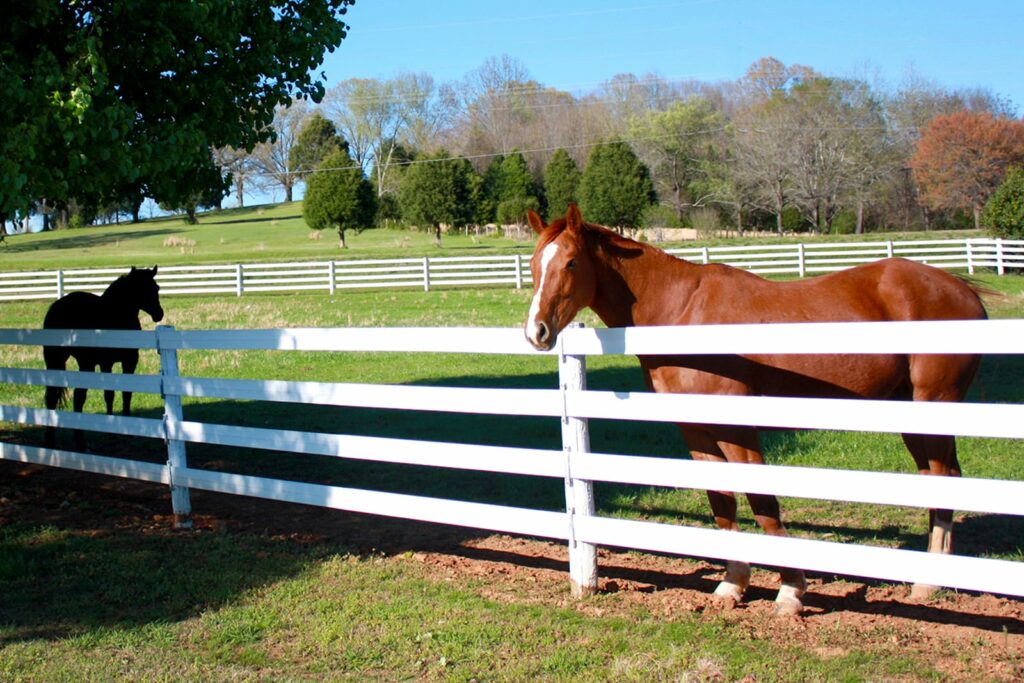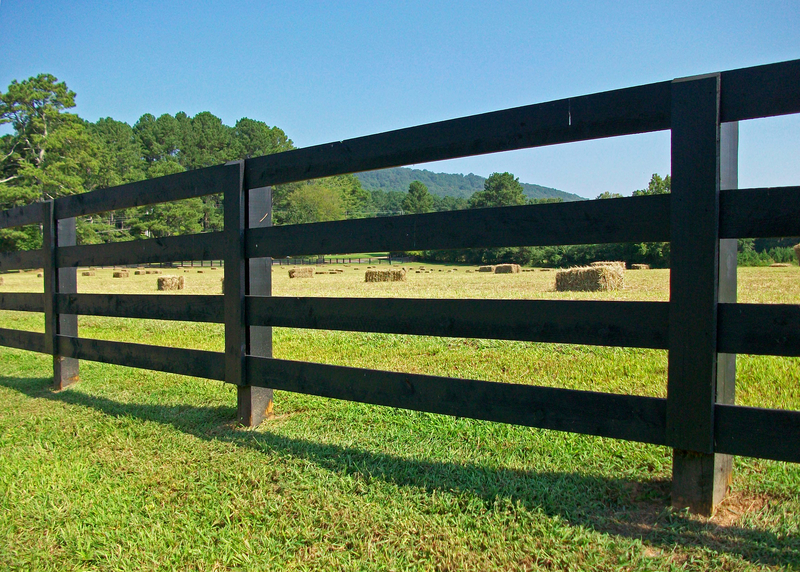Stock & Noble
Safety Check: Does My Horse Risk Injury if I Use Steel Post and Rail Fencing?
- BY Tripti Kakkar

Imagine this: you’ve carefully set up your horse’s enclosure, complete with sturdy steel fencing to ensure their safety and security. However, despite your best efforts, there’s a persistent worry nagging at the back of your mind – could this seemingly reliable fencing pose a risk to your horses?
The safety and well-being of your equine companions matter the most, and the last thing you want is for them to face any unnecessary harm.
Here at Stock & Noble, we understand the bond between you and your four-legged friends and the deep-seated concern for their welfare. We have years of experience in providing the finest and safest horse fencing solutions to equestrians around Australia and New Zealand. Our Premium Steel Post and Rail fencing has been specifically designed and successfully proven to be horse-safe.
Over the years, we’ve understood the challenges and risks that come with steel fencing. Through our extensive knowledge and hands-on experience, we’ve put together a helpful guide to keep your horses safe from getting injured by steel fencing.
In this blog, we’ll discuss the potential risks associated with steel fencing, providing practical insights and actionable steps to manage these risks effectively.
By the end, you’ll walk away with a complete understanding of the best practices and strategies to ensure the safety and well-being of your favourite animals, creating a secure and nurturing property for them to thrive in.
Steel Fencing and Horses: Understanding the problems and risks.
Steel fencing covers a wide spectrum of products, from Cattle Rail and steel wire fencing to steel mesh and Buckley Fencing Systems. However, in this article, we will only be discussing the Steel post and rail fencing.
True story, we’ve had clients ask us about alternatives to steel fencing because their horse got spooked and ran into the welded steel fence and broke its leg. This resulted in the horse being put down.
We agree steel fencing while robust, durable and long-lasting, can also pose some serious challenges for your horses.
Entanglement:
Horses may get their hooves or legs caught in the gaps between the steel rails, leading to potential injuries.
Impact injuries:
This is probably the scariest one! If a horse accidentally runs into the galvanised steel posts or rails like the Cattle rail which will not give way to the spooked horse, it can cause significant injuries, resulting in cuts, bruises, or even fractures.
Improper installation:
If the steel fencing is not set up correctly, it could be unstable or have sharp edges, increasing the risk of injury to horses in the area.
Rust and corrosion:
Over time, steel fencing can rust or corrode, leading to weakened spots that might break or collapse, posing a risk of injury to horses.
How to Protect Your Horses from Steel Fencing Hazards
Step#1: Check the need for Steel Fencing on Your Property
The first step is to evaluate whether and why you need steel post and rail fencing on your property.
Is it the presence of termites or reactive soil, the necessity for functionality, the need for a low-maintenance solution, the scarcity of premium hardwood, the lack of warranty on other fencing solutions or do you simply prefer the aesthetics of a premium steel fencing solutions like Buckley?
It’s important to know the reason for choosing steel post and rail fencing for your horses so you can take the required precautionary steps once it is installed.
Step# 2: Evaluate Different Types of Steel Post and Rail Fencing Options
Do you know the details of all the different types of steel post and rail fencing available in Australia and their key differences?
It’s worth learning about them and choosing the one that is the perfect match for your property, your vision, your animals and your budget.
Step #3: Explore Premium Steel Fencing Option
When it comes to steel posts and rail fencing, not all options are created equal. Opting for premium solutions like the Buckley system from Stock & Noble, specifically designed for horse safety, can offer both high aesthetics and peace of mind.
The unique design of the Premium Steel Post and Rail has a bend, buckle and release system engineered into its fencing. When a spooked horse runs into Buckley, the rails are designed to give way and let the horse go. This helps to prevent any potential injury to the horse that may happen if the same scenario is repeated with Cattle Rail fencing.
Buckley Steel Post and Rail Fencing System recently being chosen by the largest equine hospital in the Southern Hemisphere, underscores its efficacy in providing a secure enclosure with high horse safety standards.
Step #4: Consider Minimising Steel Usage for Horse Safety
If you have an exclusively equine property and cannot fit Buckley fencing in your budget the next best idea is to minimise the quantity of steel used in your fencing.
While opting for welded cattle rail might seem like a cost-effective solution, it brings forth a range of safety concerns that cannot be ignored.
Introducing horserail with hogan posts featuring steel end assemblies could be one of the solutions. So, you can have flexible rail and plastic posts for the majority of the fencing and it can significantly reduce the overall usage of steel while maintaining the necessary structural integrity.
Step #5: Add Electrics to Your Steel Fencing
If the horses consistently disrespect the fence and approach it for rubbing their backs etc., then adding electrics to your steel fencing like Hotcote or Equirope might help.
It can deter horses from interacting with the fence, however, it’s important to note that these measures might not prevent injuries if the horses run at high speeds due to fear or panic. Especially if you have Cattle Rail, you need to stay cautious.
Step#6: Choose Smooth Edges for Safe Fencing
Sharp edges on steel fencing can be a potential hazard for horses. As they move around their enclosures, play, or simply graze, contact with sharp edges can lead to cuts, grazes, or more severe injuries. To address this concern, it’s important to select fencing materials with rounded and smooth edges.
When constructing your fencing, keep a keen eye on the profiles of the steel you choose. Look for steel profiles that are more oval rather than rectangular or square.
Options like Cattle Rail and Buckley stand out for their design, featuring rounded and smooth edges that minimise the risk of harm to horses.
Step#6: Capping Steel Posts for Safety
Another crucial safety measure when working with steel fencing involves capping the steel posts. Steel posts can sometimes have exposed edges that may pose a risk of injury to horses. By adding caps, whether round or square, you effectively cover these sharp edges, making them horse-safe.
Step #7: Proper Fence Installation and Maintenance
Proper installation and regular maintenance are crucial in preventing injuries caused by steel fencing. During installation, ensure that the fence is appropriately installed and that all components are securely fastened. Regularly inspect the fence for signs of wear and tear, and promptly address any issues such as rust, loose fixings, or damaged sections.
Applying rust-resistant coatings, using pre-powdered steel post and rail and conducting routine checks can significantly contribute to maintaining a safe and secure fencing environment for your horses.
It’ll be worth learning further about the performance of different types of steel fences against rust.
Confident to Keep Your Horses Safe While Using Steel Fencing?
Over time, horses learn to respect all types of fencing. If they occasionally rub their backs against the fence, the presence of electric wires helps them learn to respect boundaries.
Even spirited horses eventually understand the limits of their enclosure and stay within the designated boundary. However, the real challenge arises when they unexpectedly run into the fence. This is precisely why it’s crucial for the fencing to incorporate safety features to prevent any potential injuries to the horses.
By following the steps outlined in this article, you can ensure that your horses stay safe and secure within their environment, giving you peace of mind and allowing them to roam without any unnecessary risks or hazards.
Choosing the right kind of steel fencing is important. Options like Buckley’s Premium Steel Post and Rail Fencing are great because they’re designed with the safety of horses in mind. Always remember to take good care of your steel fencing. Make sure everything is secure, smooth, and regularly checked for any signs of damage.
While the aspect of safety has been tackled, the next step is to find out which steel post and rail fencing is best for your equine property based on other factors like cost, quality, performance and longevity.
If you have any further questions on how to ensure the safety of your horses using different fencing solutions, a professional consultation would be ideal. Feel free to connect with our fencing experts who’ll guide you every step of the way to build a safe and beautiful equine property. Just the way you dreamed.



